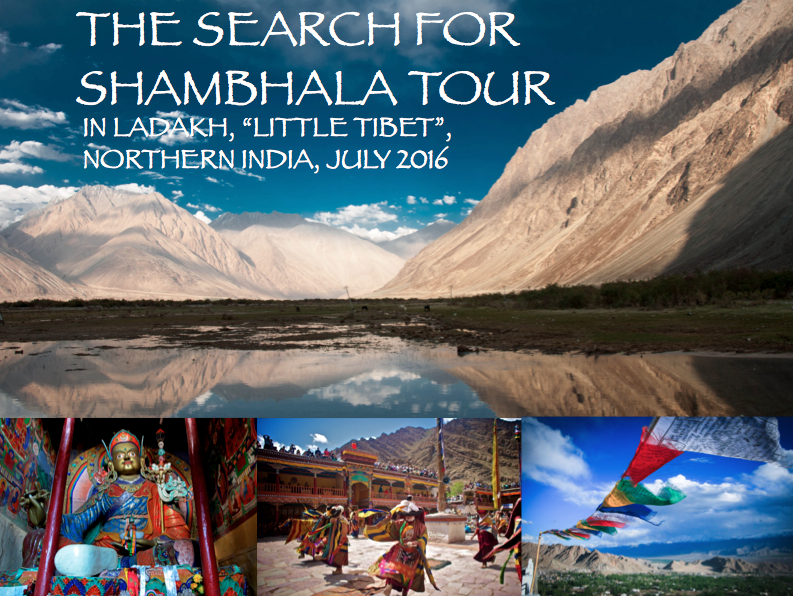

Andrew Collins and Megalithomania
IN
ASSOCIATION WITH
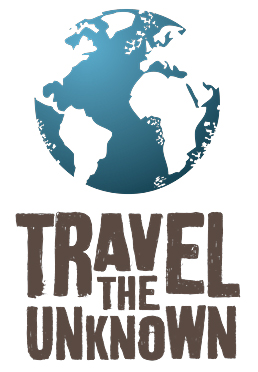
Present
The
Search for Shambhala
Monday, 11 July - Monday, 25 July 2016
EXPLORE THE LOST WORLD OF LADAKH, NORTHERN INDIA'S OWN "LITTLE TIBET"
FOLLOW IN THE FOOTSTEPS OF PADMASAMBHAVA, MILAREPA, NICHOLAS ROERICH AND OTHERS
In July 2016 join tour guides Andrew Collins and Hugh Newman in the Search for the Lost World of Shambhala
* Visit fully functional Tibetan Buddhist monasteries in Ladakh, "Little Tibet," located in North India's Jammu & Kashmir province.
* Visit the temples and caves where Padmasambhava, the pioneering founder of Tibetan Buddhism, meditated on his journey to Tibet
* Inspect prehistoric rock art, ancient structures, as well as Tibetan Buddhist chortens and shrines
* Experience the world-famous Hemis festival, dedicated to Padmasambhava
* Journey to the Karakoram Mountains and come within a stone's throw of the legendary entrance to Shambhala
* Relax and meditate for two days in a remote Tibetan Buddhist retreat
* Learn about Shambhala and its place in mythology and legend
* Tour also includes a day visit to Delhi's Qutab sufi complex and archaeological park where you will see the famous Qutab Minar tower and legendary Iron Pillar
15
days/14 nights
Delhi ~ Leh ~ Lamayuru ~ Alchi ~ Likir ~ Ney ~ Leh ~ Nubra
~ Diskit ~ Leh ~ Delhi
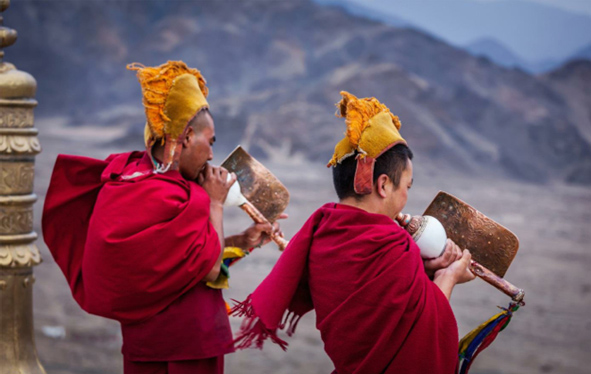
Day
01: July 11 - Arrive at Delhi
Arrive
at New Delhi’s International Airport. Following customs, immigration formalities
and baggage collection, our representative will meet you as you exit the arrival
terminal building after which you would be transferred to your hotel.
India’s
capital and a major gateway to the country, contemporary Delhi is a bustling metropolis,
which successfully combines in its folds - the ancient with the modern. Amidst
the fast spiralling skyscrapers the remnants of a bygone time in the form of its
many monuments stand as silent reminders to the region’s ancient legacy.
The first impressions for any visitor traveling in from the airport are of a specious,
garden city, tree-lined with a number of beautiful parks. Upon arrival at the
hotel, proceed for check-in at the hotel. Stay overnight at hotel.

Day
02: July 12 - Delhi
Morning
proceed for sightseeing of New Delhi visiting Qutab Minar, Archaeological Park
and Iron Pillar.
Qutab Minar is amongst the tallest and the most famous monuments
in the world. This beautiful minaret is 234 feet high and is regarded as the tallest
individual tower in the world. Qutbu'd-Din Aibak laid the foundation of Minar
in AD 1199 for the use of the mu'azzin (crier) to give calls for prayer and raised
the first storey, to which were added three more storeys by his successor and
son-in-law, Shamsu'd-Din Iltutmish (AD 1211-36). Archaeological Park bordering
the Qutb Minar complex, but overlooked by most of the tourist hordes, the Mehrauli
Archaeological Park protects the most climatic relics of the second city of Delhi.
Scattered around a timberland park are the vestiges of many tombs, royal residence
structures and pilgrim habits.
The Iron Pillar is one of the world's preeminent metallurgical interests - its rust resistant composition and mysterious nature leading to its inclusion in books by ancient astronaut theorist Erich von Däniken. The column is 7.21-metres high and estimated weight of the decorative bell of the pillar is 646 kg while the main body weighs 5,865kg, thus making the entire pillar weigh 6,511 kg. The pillar bears an inscription in Sanskrit in Brahmi script dating 4th century AD, which indicates that the pillar was set up as a Vishnudhvaja, standard of God, on the hill known as Vishnupada in memory of a mighty king named Chandra, believed to Chandragupta II. Stay overnight at hotel.
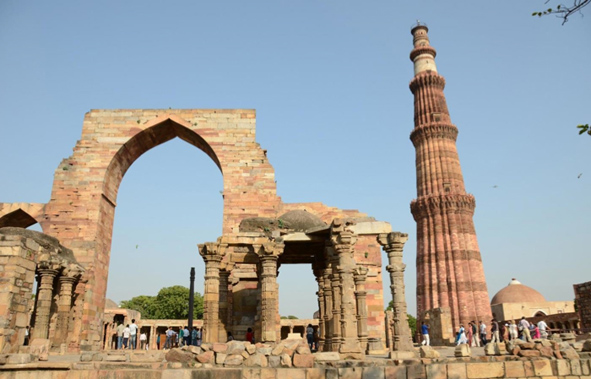
Qutab
Minar, Archaeological Park.
Day
03: July 13 - Delhi to Leh (By Air)
Morning
transfer to New Delhi Airport to board flight for Leh. Flight Details Air India/AI
445
New Delhi Departure 0625 HRS. Leh Arrival 0745 HRS
Upon
arrival at Leh Airport our representative will meet you as you exit the arrival
terminal building after which you would be transferred to your hotel.
Leh,
the capital of Ladakh lies amidst the snow-capped hills of Himalayas with many
monasteries and colourful markets. It is also the Buddhist capital of North India.
At a height of 11,000 feet, there are many strikingly beautiful and majestic mountains
here, which slowly merge into an oasis of green fields.
Rest of the day is
at leisure for acclimatisation. Stay overnight at hotel.
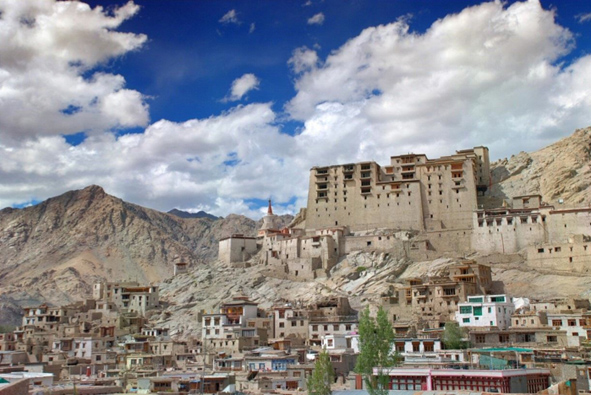
View
of Leh.
Day
04: July 14 - Leh
Morning
proceed to visit Takhok Monastery and Duphug (Tu-Phuk) Lhakhang.
Takhok Monastery is situated in Sakti town. Its name implies the "rooftop top", because of it being developed against a stone divider at 3880m above ocean level, beside a meditational hollow where Padmasambhava, the spearheading author of Tibetan Buddhism is said to have lived and meditated for three years, prior to his celebrated journey to Tibet in the eighth century. Takthok Monastery is the only religious community in Ladakh lodging the red-cap school of ministers known as the Nyingma-pa, who claim a genealogy direct from Padmasambhava himself.
Some
Nyingma-pa monks and lamas follow a secret doctrine known as Dzogchen, and believe
in what is known as Terma retrieval. This is the finding of hidden holy relics
and scriptures left by Padmasambhava on his journey through Ladakh. Termas are
found through the intervention of dakini spirits who appear in dreams and visions.
The monks and lamas present of Takthok are called upon regularly to help rid victims
of evil spirits, epidemics and curses.
Duphug
(or Tu-Phuk) Lhakhang is a cave, watched by consecrated yak horns, and is infrequently
open to guests. It contains pictures demonstrating the eight types of Padmasambha,
alongside an eleven-headed Chenresi (Avalokitsshvara). In the cloister's primary
get together corridor, is a throne that can be utilized just by the Dalai Lama.
Proceed to visit Hemis Monastery to experience the Hemis Festival.

Hemis
monastery.
Hemis
Gompa (Monastery) is one of the biggest and by far the best known Gompas of Tibetan
Buddhism in Ladakh. Situated at a distance of 40 kms from Leh across the Indus,
the monastery is not visible from the road as it is located in a side Valley.
This monastery is dedicated to Guru Padmasambhava, the founder of Tibetan Buddhism.
There are a number of gold statues decorated with precious stones in it. There
are numerous Tangkhas on the walls and in these Tangkhas life of Buddha is described
in a very beautiful manner. The biggest Tangkha is displayed once in eleven years.
The Hemis Gompa is known for the annual fair (Hemis Festival) which attracts travellers from different parts of the world; the main features are the mystery plays, interspersed with lama dances, enacted on the occasion. The 10th day (Tses - Chu) of the Tibetan lunar month is celebrated as the birthday of Guru Padmasambhava (Guru Rimpoche), the Founder of Tibetan Buddhism. The Hemis Monastery celebrates this event in the form of a 2 day festival. Its resident Lamas perform sacred masked dances. The festival takes an auspicious turn every 12 years in the Tibetan year of the Monkey, when the two-storey high "Thangka" depicting Guru Padmasambhava is displayed. The festival begins with a procession of the Lamas with the Head lama the Rimpoche taking the head seat in the courtyard of the Monastery. After the prayers the festivities begin.

The
spectacular Hemis festival.
Later
visit Chemrey Monastery.
Chemrey Monastery was started in March 1644 and completed in 1645 or 1646. Overlooking fields and houses, the monastery is perched picturesquely atop a small hill, down one side of which spill the monks' dwellings. The main du-khang, a large rather bare temple, has images of Stag-tsang-ras-pa and other Drug-pa lamas, together with fine silver Chorten about fifty years old made at Chilling. One of the main attractions is a one-storey tall image of Padmasambhava.
Close by is another sacred cave where Padmasambhava is said to have meditated on his journey through Ladakh.
A temple to the Hindu goddess Kali stands at the base of the hill on which the monastery stands. It was built after a monk is said to have hit a Mongol king's teacup with a bullet from a rifle. This incident happened after the Mongolians had laid siege to the monastery. Stunned, the Mongol king thought this must be a sign from the goddess Kali, and so immediately made peace with the monks, so they built a temple in her honour.
Stay overnight at hotel.

The
Stok Royal palace.
Day 05: July 15 - Leh Morning proceed to visit Stok Royal Palace.
The
Palace of the banished royal family was founded in the fourteenth century by Lama
Lhawang. Its library houses the 108 volumes of Buddha’s teachings. Stok has
a museum which displays fabulous period costumes and jewelry of the royalty along
with exquisite Tangkhas representing the life of the Sakya-Muni Buddha. Interesting
historical objects like coins, seals, armour, weapons, precious jade and porcelain
can also be seen here.
Inside the palace at Stok is a museum containing the king of Ladakh's crown, along with the queen's personal headgear, which has 108 turquoise pieces set into it. See also her royal dresses, jewellery, the wooden palanquin used during the couple's marriage ceremony and other personal items belonging to the royal family.
Later
visit Spituk monastery and Phyang monastery. Spituk monastery belongs to Gelug-pa
sect (Yellow Head sect): The Spituk Gompa, 8km southwest of Leh, was founded by
Od-Ide, in the 11th century AD; when the monastic community was introduced. Meanwhile,
Lotsava Rinchen Zangpo (the great translator) visited this monastery. In those
days the Gonpa belonged to the Kadampa School but Gelukpa order was introduced
during the reign of King Dragspa Bum-Lde, when Lama Lhawang Lotus restored the
monastery. The "Spituk Gustor" takes place in the courtyard of the monastery,
on the 18th and 19th of the 11th month of Tibetan Calendar.
Phyang
monastery, 17km west of Leh is remarkably built on the hilltop, similar to the
Likir monastery. This monastery belongs to the Degungpa Order. It was the first
monastery, which introduced the Degungpa teaching of 'Skyob Jigsten Gonbo' in
Ladakh that was founded by Chosje Danma Kunga, during the reign of King Jamyang
Namgyal in the 16th Century AD. It has about 50 monks in residence. Phyang also
has a festival called 'Phyang Tseruk' on the 2nd & 3rd of the 6th month of
Tibetan Calendar. Stay overnight at hotel.
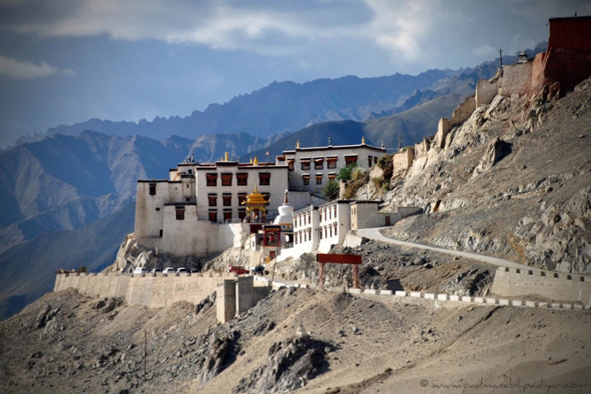
Sputik
monastery.
Day
06: July 16 - Leh to Lamayuru (130 Kms/05 hrs)
Morning enjoy an excursion to Lamayuru, en-route photo stop at Zanskar and confluence of the Indus River. The Lamayuru "Yungdrung" Gompa is remarkably built on a rock, west of Leh, on the Leh-Srinagar highway. Lamayuru belongs to the Drigunpa order of Tibetan Buddhism. The history of the monastery begins with the visit of Arahat Nimagung to this place, when there was merely a lake here. It is said that Arahat made a prophecy that "a monastery will come up at this spot" and he made offerings (prayer with grains of corn) to the Nagaserpent spirits. The corns mixed with the earth and formed in the shape of Swastika (Yungdrung), later it came to be known as Yungdrung Monastery. The Great Translator Rinchen Zangpo constructed a temple here in eleventh century on behalf of the king of Ladakh. He ordered that exactly 108 monasteries be built in Ladakh, with Lamayuru one of them.
The
site of the Lamayuru monastery is claimed to be the place where Milarepa, the
great Tibetan yogi, founded the Kagyu school of Tibetan Buddhism. There is evidence
also that the site was sacred to the Bon-po religion before the advent of Tibetan
Buddhism. Lamayuru is run by just 30 monks of the Brigunpa branch of the Kagyu
school, the last of 400 monks present here just a century ago. Nearby is the Naropa
Cave named after Naropa, an eleventh century Buddhist Mahasiddha who was teacher
to Milarepa, sat in meditation. Indeed, Milarepa himself is thought to have sheltered
here during his long journey through the Himalayas.
Gelug-pa or Kadam-pa school of Tibetan Buddhism initially looked after Lamayuru, but later it was taken over by the Digung-pa Order. Its monastic festival is called "Yuru Kabgyat", takes place on 17th and 18th of 5th month of the Tibetan Calendar. Stay overnight at hotel.

The
ancient Lamayuru monastery.
Day
07: July 17 - Lamayuru to Alchi (60 kms/ 02 hrs)
Morning
proceed to visit Alchi village and Alchi Monastery.
Alchi
monastery was founded in the 11th century by Rinchen Zangpo the Great Translator;
it was richly decorated by artists from Kashmir and Tibet. Paintings of the Mandala’s
which have deep Tantric significances are particularly fine; some decorations
are reminiscent of Byzantine art. One of its walls features thousands of miniature
sized pictures of the Buddha. Three large sized images made of clay and painted
brightly are its focal attractions. No longer an active religious center, it is
looked after by monks from the Liker monastery. This is the only monastery amongst
34 monasteries in Ladakh that is not located on a hilltop.
From here, go down
to the Indus River where the group will conduct a meditation and make offerings
of flowers to the spirit of the river.
Stay overnight at hotel.
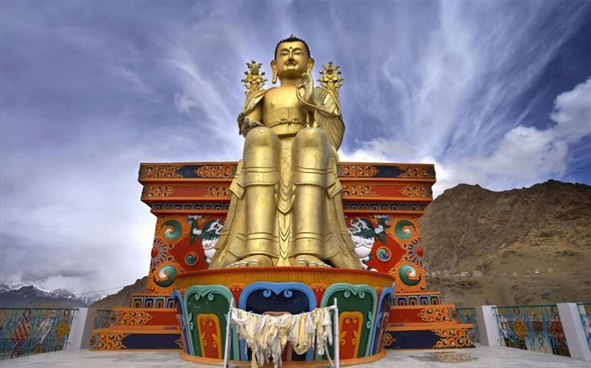
Day
08: July 18 - Alchi to Likir (20 Kms/ 1.5 Hrs)
Morning
proceed to visit Likir Gompa.
Likir
is situated in a side valley about 05 Kms from main Srinagar - Leh highway. Likir
belongs to the Gelug-Pa sect; the monastery also maintains and runs a school for
young Lamas.
Likir Gompa was founded in the 11th century and rededicated to a different monastic order in the 15th century; its earlier Gompa was destroyed in a fire. The present Gompa dated back to the 18th century. Skilled craftsmen producing excellent thankas, earthen pots and carved wooden folding stools, live here in the village. Majestically situated, Likir commands a spectacular view.
The
Likir monastery stands on a hill that bears the likeness of a coiled snake. Indeed,
the name Likir comes from lukhgil (or klu-khil), meaning "coiled snake."
It is believed by local Buddhists that here once slept the Snake King Jokpo, and
that even today the site is guarded by the spirits of two magical snakes, Nanda
and Taksako. Having as many as a hundred monks in residence, Likir is a highly
active monastery. One of its principal attractions is a 23-metre high statue of
Maitreya, which sits on a pedestal out in the open. The head Lama at Likir is
the younger brother of the Dalai Lama.
Stay
overnight at hotel.
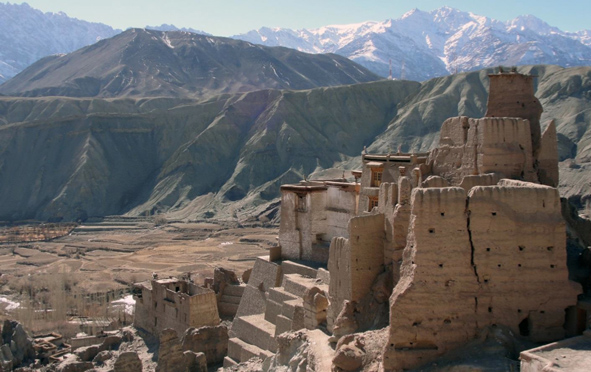
The
atmospheric Basgo monastery.
Day
09: July 19 - Likir to Ney (20 Kms/ 1.5 Hrs)
In
the morning you will be transferred to Thagchokling Retreat Centre.
The
Thagchokling Retreat Centre, called the "Stairway to Heaven," is situated
in the Ney Valley, near the Basgo religious community.
It
was manufactured by a German who – together with Lochos Rinpoche – had
the thought of an intercultural and interreligious meeting spot for East and West.
His Holiness, the Dalai Lama, unequivocally respected this thought and gave his
gift for the establishment stone in August 2002. The traditional building was
constructed on the ruins of an old village temple, now it is surrounded by an
abundant flower and vegetable garden.
This
area, set at a stature of 3500 m above sea level, conjures the same inward peace
and quietness experienced by Padmasambhava when he sheltered in the nearby caves
on his celebrated journey through Ladakh. A small library with English and German
books on Buddhism and Ladakh invites guests to enjoy reading in the sunshine.
Stay overnight at retreat centre.
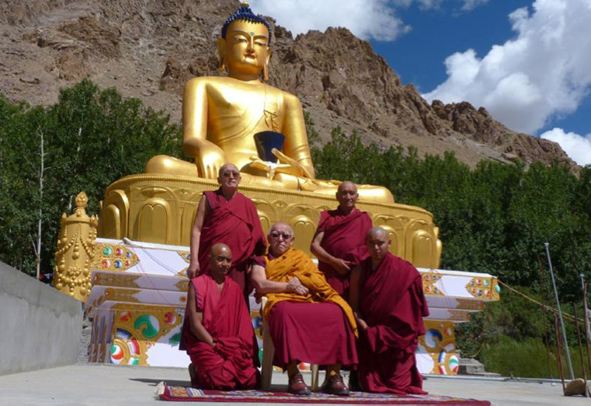
Thagchokling
Retreat Centre in the Ney Valley.
Day
10: July 20 - Ney Valley
Day
is at leisure to for personal activities.
There are plenty of options to spend the time at Thagchokling: relax, slow down, regain your energy, meditate, do yoga, take a walk, sit next to the river and enjoy the murmur of the water, gaze to the sparkling stars or watch the farmers at their daily chores. A roof-top prayer room is always open for those looking for a place to meditate or wishing to join the puja (prayer ceremony) with the resident lama. Andrew Collins was conduct meditations on Shambhala during our stay in the retreat.
The
retreat is a peaceful place for visitors, who are invited to hold their own programs
here and for individuals who have the time to satisfy a deeper interest in Ladakh,
its religion, art, country and people.
Stay overnight at retreat centre.
Day
11: July 21 - Ney to Leh (50 Kms/ 02 Hrs)
Morning
drive back to Leh, en-route visit Basgo Gompa.
Basgo
is a historical town situated on the bank of the Indus River in Ladakh. It was
once an important cultural and political centre and is frequently mentioned in
the Ladakhi Chronicles. It is known for its Gompas such as Basgo Monastery and
historical ruins.
Basgo
Gompa is located at a high impregnable position, which enabled it to withstand,
a three year siege in the 17th century but got severely damaged during the Dogra
wars in the year of 1834.
Since
then the unfired clay brick structure has been slowly crumbling, leaving a few
walls and towers to speak of the grandeur of days gone by. The highest tower with
a Lhato still appears to be guarding the three important shrines dedicated to
the Maitreya Buddha. The statues in these shrines are among the oldest representation
of the Maitreya Buddha in existence in India.
Towards
the northeast is situated the Ngangpa Ri - a sacred mountain with remnants of
ancient hermitages. To the southeast it looks over the land towards the mighty
Indus River. The three shrines have murals, manuscripts besides the statues at
Basgo Gompa Ladakh
Stay overnight at hotel.
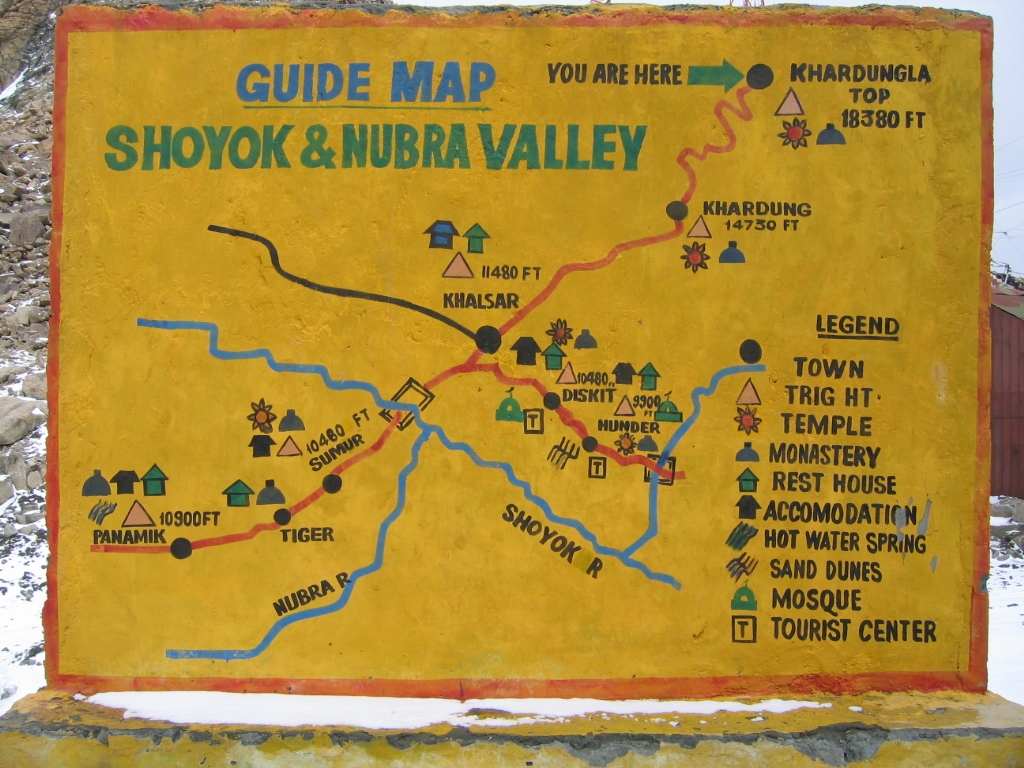
Map
of Shyok and Nubra Valleys on local signpost (Pic credit: Wiki Commons Agreement).
Day
12: July 22 - Leh to Nubra (160 Kms/ 05 hrs)
Early
morning by surface travel to Nubra Valley.
Today
you will be passing through Khardungla Pass (5602m), the world's highest motorable
road.
Later
visit Hunder Village.
Hunder
is a beautiful village and you will really enjoy your stay at Hunder. The village
sits like an oasis in the middle of the cold desert in Nubra valley. It has a
small monastery and ruined fort above the village. 07 kms from Diskit which is
known for its Buddhist monastery, Nubra has acquired fame for its sand dunes and
the cold desert that surrounds it.
Situated
close the Siachen glacier and Pakistan border in Jammu and Kashmir in north India,
entry beyond Hunder village is barred as the area ahead is controlled by the Indian
Army. The walk or Camel Safari (Double Hump Bactrian camels) from Hunder to Diskit,
through sand dunes is a wonderful experience.
Stay overnight in eco-camps (comfortable
tented accommodation).

Sand
dunes near Diskit.
Day
13: July 23 - Nubra Valley
Morning
visit the Samtanling Monastery to witness the prayer.
Later
visit Panamik Hot Springs which are rich in Sulphur contents & believed to
have medicinal benefits. You may take a bath at springs.
In
the afternoon you will visit Diskit Monastery.
Diskit
is celebrated for its fourteenth century religious community, accepted to be the
biggest and most established cloister in Nubra valley. Diskit is arranged at an
elevation of 10,310 ft above sea level, at the edge of the desert in Shyok valley.
Among the bigger towns, Diskit is the regulatory focal point of Nubra valley.
Diskit cloister was given to Rimpoche of Thiksey religious community amid eighteenth
century. It is still under the administration of Thiksey religious community and
thus, considered a sub-gompa of Thiksey.
Today
you will see the Neolithic rock carvings of Diskit in the Shyok river valley.
Also see the carvings in Mugri Tokpo. These show hunting scenes and animals of
various kinds.
Stay
overnight in camps
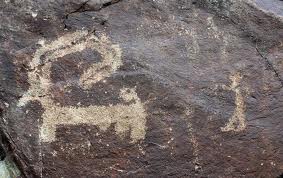
Petroglyphs
in the Nubra Valley.
Day
14: July 24 - Nubra to Leh (160 Kms/ 05 hrs)
Morning
transfer to Leh, via Khardungla Pass. In the evening explore Leh bazaar, Jokhang
or Leh Mosque.
Stay overnight at hotel.
Day
15: July 25 - Leh to Delhi (By Air)
Early
morning transfer to Leh airport to board flight for Delhi.
Flight
Details Jet Airways/9W 2369
Leh
Departure 0740 HRS
New
Delhi Arrival 0915 HRS
Upon
arrival in Delhi transfer to International airport connect flight for onward journey.
Alternatively,
add-on tours elsewhere in India can be arranged.
Tibetan
thanka possibly showing Djepo, king of Shambhala, on a windhorse.
THE
SEARCH FOR SHAMBHALA
An Introduction by Andrew Collins
Shambhala is a mythical land long said to have existed beyond the northern bounds of Tibet and India. Here lived immortal beings that secretly ruled the known world. Shambhala's immortal king, Djepo, was said to ride a winged windhorse. The Chinese have their own concept of Shambhala, focused around the mountain of the Immortals named Kunlun. Here reigned Xi Wangmu, the Spirit Mother of the West, who every 3,000 years holds a party for mortals kings, one of whom is presented with a ripe peach from the Tree of Immortality. The location of Kunlun was lost far back in antiquity, and expeditions commissioned by Chinese kings failed to find its whereabouts. All anybody knew was that it lay, like the Shambhala of Hindu and Buddhist tradition, somewhere in the area of the modernly-named Kunlun Mountains that form the border between China and Tibet.
Is Shambhala the memory of a lost civilization that once existed in Central Asia? It is a mythical realm, home of supernatural beings? Or does it exist on another dimension, its entrance a portal between this world and the next?
When Russian mystical artist, writer and explorer Nicholas Roerich (1874-1947) passed between Ladakh and the Karakoram Pass his sherpas told him that nearby were hidden entrances to caves that led to otherworldly realms. Did they lead to Shambhala?
The Search for Shambhala tour will investigate the mystery of Shambhala. We shall explore its otherworldly existence during meditations and attunements, especially during the two-day retreat and also when in the Nubra and Shyok Valleys, so close to the Karakoram Pass, the ancient border between India and China. We will also ask the Tibetan Buddhist monks, guides and lamas their own views on its reality and whereabouts. No one can predict what will happen on this extraordinary path of discovery and enlightenment. Join us in Ladakh in 2016.
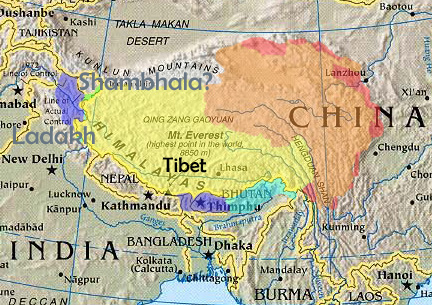
Map
of India and Tibet showing the possible location of Shambhala (pic credit: Wiki
Commons Agreement).
TOUR OF LADAKH, INDIA'S "LITTLE TIBET"
15 DAYS/ 14 NIGHTS
Monday, 11 July - Monday, 25 July 2016
(meet Delphi International Airport)
Cost per person based on double occupancy
£2,295
Single occupancy supplement: £375
The above price includes:
-
Domestic flights (airfare subject to change)
- Airport transfers
- Accommodation
(14 nights)
- Ground transport in Delhi and Ladakh
- Meals: full board,
except in Delhi
- Sightseeing and entry fees to sites
- Inner line permit
to enter certain parts of Ladakh
- Escorted guide (from our side)
- Your
places on single room basis and your domestic flights (airfare subject to change)
TOUR
DEPOSIT £500
Pay deposit now using the Travel the Unknown payment page:
http://www.traveltheunknown.com/cardpayment
(On
paying add the description or name of the tour)
Any problems or queries
contact either Travel
the Unknown or Andrew
Collins
The
Search for Shambhala tour is fully ATOL bonded
IMPORTANT:
Please read the Megalithomania terms and conditions prior to making your booking.
These are available by clicking below:
Andrew Collins/Megalithomania tours are no ordinary tours. They are voyages of discovery, quests for the answers to the mysteries of life, creating unforgettable moments in people's lives that are truly unique
If you have any questions regarding any aspect of the tour, then contact either Andrew Collins or Hugh Newman at Megalithomania Tours, and we'll try our very best to help you.
Early indications suggest that interest in the tour will be high, so please don’t delay.